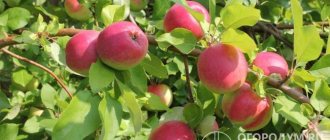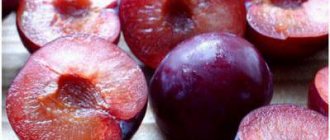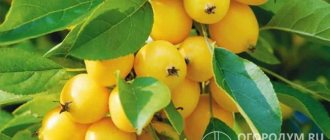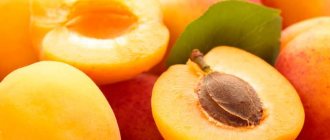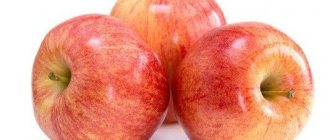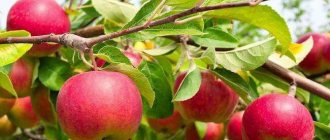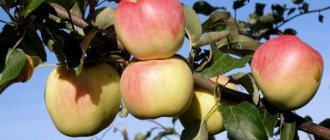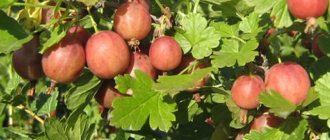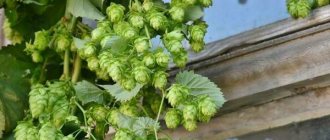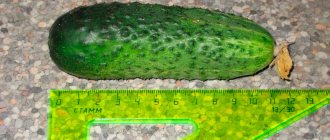Description and characteristics
A description and photo of the Kitayki apple tree variety will help you understand exactly why gardeners value it and what is remarkable about it. The plum-leaved or Chinese apple tree has a fairly large size and a remarkable crown structure. The branches grow upward, there are not many side shoots from them, but quite a lot of leaves.
Flowering is abundant and beautiful. Large-diameter white flowers are collected in abundant umbrellas. They attract the eye with their charm and lure many insects with their aroma.
The fruits are harvested in late August or early September. Their weight, shade and taste vary depending on the variety. Thus, the smallest individuals are 40 g, and there are also huge ones - 300 g.
The Chinaka apple tree variety has a number of features and positive properties for which it is valued. Among them:
- resistance to low temperatures;
- consistently high yield;
- immunity to most diseases and parasites;
- low maintenance requirements.
It is thanks to these positive qualities that breeders decided to breed many different varieties, taking the Chinese variety as a basis. They can be different in appearance and fruit, and the taste also differs significantly.
Varieties
Chinese, whose varieties differ in country of origin, properties and prevalence, amazes with its diversity. Some are more common in Russia, while others are more popular abroad. Let's consider what varieties Kitayka suggests planting and in what climate.
Kerr
A relatively young variety originally from Canada, which has already become widespread. The tree is small, it has a rounded crown, which itself grows compactly, without formation. Flowering is abundant and long lasting. Bright pink flowers completely cover the branches so that the leaves are almost invisible. The fruits are small, have a rather unique taste, but are rich in various vitamins. The apple tree is resistant to low temperatures, diseases and short-term drought.
Apple tree Chinese Kerr.
Red
The Chinese Red was bred not only for admiration, but also for use in kitchens. They can be stored for more than 60 days, dried, and prepared into compote and jam. The fruits are harvested at the end of summer; small fruits are sweet and sour, juicy and aromatic, with a beautiful red-raspberry hue.
Apple variety Kitayka Red.
For a long time
The beautiful apple tree from America is distinguished by its attractive flowers and fruits. Flowering occurs in May and lasts almost the entire month. The fruits at ripeness are very small, about 20 grams, bright red with yellow flesh and a pleasant sweet taste. They have an interesting oblong shape. It is quite possible that this is why the variety has such an unusual name. The apple tree is resistant to low temperatures and produces abundant fruit.
Chinese Long.
Yellow
The Chinese yellow tree has a neat pyramidal crown, with branches pointing upward. Fruiting begins 4 years after planting, without much effort or care in care. The only thing you need to worry about is scab protection. The fruits are small, bright yellow, pleasant in taste, and are often used to make canned sweets.
Variety Chinese Yellow.
Bellefleur Chinese
The variety is familiar to many as Paradise apples; it grows up to 6 meters in height, has a spreading crown and fairly large fruits. Bellefleur is considered a late-autumn apple tree, but recently it has been grown mostly only in private gardens, because more frost-resistant hybrids have been bred. The apple tree bears fruit late, suffers from scab and other fungal diseases, and may freeze. The fruit has a pleasant taste, they are considered dessert, sweet and sour with a pleasant aroma.
Bellefleur Chinese apples.
Pink
The beautiful Chinese pink apple tree can reach a height of up to 10 meters, so its growth must be monitored. It easily tolerates pruning and shaping, and not only in the spring. Flowering is abundant, bright and beautiful. The fruits are small, like bright balls, collected in tassels. Their shades can vary from light yellow to bright red. The harvest is abundant, but the fruits are practically not stored.
Apple tree variety Pink Chinese.
Golden
The subspecies was obtained by crossing Chinese and White filling. The apple tree has average characteristics. The fruits are small, golden in color, and have a very specific taste, even rather tasteless. The variety is resistant to low temperatures, blooms profusely and beautifully, these are all its advantages.
Golden Chinese.
Saninskaya
The tree is tall, with a spreading crown that needs shaping. Fruiting is abundant and regular, but the taste of small apples leaves much to be desired. They are practically never used fresh, but quite often they are part of all kinds of preserves. Chinese Saninskaya is even often used as a component in the preparation of spicy wine.
Apple tree Saninskaya Chinese.
Cream
Quite tall growth with late fruiting, but a lot of attractive qualities. The apple tree is resistant to low temperatures and scab, but... unfortunately, it has become less popular lately. Although from a number of representatives of the Chinese, the variety has tasty fruits, with delicate pulp.
Apples Cream Chinese.
Honey
The tall apple tree is resistant to low temperatures and produces abundant fruit. It is necessary to ensure that the tree does not become infected with scab in conditions of high humidity. The fruits are very small, but surprisingly pleasant to the taste, honey-like, as the name suggests. All sorts of jams and compotes are prepared from them.
Apple tree variety Honey Chinese.
Chinese apple tree - description
The plant differs from European varieties in its small fruits and original leaves, shaped like an elongated, pointed leaf plate of a Chinese plum. In its genotypes one can find signs of a real and berry apple tree. Alternative names for interspecific hybrids are plum-leaved apple tree, Raika. Ranetki and decorative crabs, which differ in fruit quality and origin, are often included in this group.
Benefits of the Chinese apple tree:
- Fruiting is fast.
- Abundant yield.
- Decorative.
- Unpretentiousness.
- You can choose a variety of paradise apples with good taste.
- Increased frost resistance.
- The frequency of fruiting is absent or weak.
- Suitable as a drought-resistant and frost-resistant rootstock.
Disadvantages of the Chinese apple tree:
- Many varieties with low consumer qualities.
- The apples fall off quickly.
- The fruits do not last long.
- Grafting with large-fruited varieties does not always give satisfactory results.
What does a Chinese apple tree look like?
Horticultural culture looks decorative on a summer cottage, standing out among the plantings with its original appearance. Externally, true plum-leaved Raika is distinguished from other small-fruited trees by the following characteristics:
- The tree is deciduous.
- Crown height – 3-8 m.
- The color of the shoots is grayish-brown or with a purple tint.
- The color of the buds is red-brown.
- The foliage is pointed, the edges of the plates are jagged.
- It is interesting to watch the Chinese apple tree bloom. The shape of the inflorescences is umbrella-shaped shields up to 8 cm in size. The number of flowers is up to 10 pcs.
- The color of the buds is pink, the petals are white.
- Flowering period is April-May.
- The size of the apples is 2-2.5 cm.
- The color of the fruit is yellow or red.
Chinese apple tree - ripening period
They tried to cross the small-fruited tree with many European varieties. As a result, the plum-leaved apple tree family now includes many high-quality hybrids that differ radically in consumer characteristics. Let's look at examples of Chinese women with completely different ripening periods:
- Golden early
- mid-August. - Saninskaya
- late summer. - Honey
- late summer. - Cream
– ripening in September. - Long
- autumn. - Kerr
- late autumn. - Kandil-Chinese
- late winter. - Borsdorf Chinese
- late winter.
Chinese apple tree - winter hardiness
In comparison with trees of European selection, this species is considered more hardy. The Chinese apple tree grows without problems in Altai, Kazakhstan, the Volga region and the northwestern regions. Plants tolerate cold winters of -30°C and even slightly below. In terms of durability, it is surpassed only by ranetka and apple berry. Chinese velvet, Saninskaya, Late Winter, Chinese mother are good rootstocks for large-fruited varieties that have problems with frost resistance.
Chinese apple tree – taste
It is difficult to classify varieties of plum-leaved Raika as standards, but among them you can find specimens with good characteristics. The Golden early Chinese apple tree has a delicate sweet and sour taste; the fruits of Dolgo and Kerr are famous for their pleasant aroma. In terms of sweetness, small-fruited hybrids Long Sweet and Honey should be ranked first. Apples from the harvest of other Chinese varieties are more sour for fresh consumption, but are good in compotes, preserves, and jams.
Features of cultivation
Like any other apple trees, Chinese apple trees need care and attention. However, there are no special features in cultivation; all procedures are standard and familiar. The height of the apple tree, resistance to cold and other features depend on the variety, but there are some general points. All apple trees must be watered, fed, pruned and crown shaped in a timely manner. Care should be taken to prepare for winter: even the most frost-resistant varieties need to remove the trunk circle and whiten the trunk. Regular inspection of apple trees for pests can save the entire harvest. And spring spraying will protect fruit trees from scab.
How to grow, care, pests and diseases
Planting a Chinese apple tree is quite simple, and the tree is also easy to care for. Trees just don’t like too wet soil, and the planting location doesn’t really matter. Apple trees of this variety can also be planted in slightly shaded areas. Before planting, there is no particular need to fertilize the soil or feed it. The seedling should be tied to a peg and watered with 2 buckets of water.
Care consists of the following manipulations:
- branches are pruned in spring;
- watered;
- sprayed against diseases with Bordeaux mixture;
- fertilize and loosen the circle around the trunk;
- The branches are pruned and bent back in the summer, when the apple tree bears fruit.
To protect the tree from pests, it is necessary in the fall to wrap the trunk with material that does not allow moisture to pass through, and the tree should not rot. In spring, the bottom of the apple tree should be whitened or painted with water-based paint.
Proper care
Let us clarify in more detail a few points that relate to the features of care. If the Chinese apple tree seedlings are purchased from a trusted seller and planted correctly, then they are accepted without any problems.
Watering the apple tree.
Watering
Adding moisture to the Kitayka variety is no different from watering other apple trees. Usually it is enough to add moisture three times a season, starting in the spring, during the ripening of the fruits, and in the fall, to prepare the apple tree for the cold. In summer, sprinkling can be done, especially in dry weather. After adding moisture, you need to loosen the tree trunk circle, and, most importantly, avoid stagnation.
Top dressing
It is necessary to fertilize the apple tree according to the standard scheme: in spring, summer and autumn. At the beginning of the growing season, you need to apply fertilizers with nitrogen, as the ovaries appear, with nitrophos, and after harvesting with potassium and superphosphate. Autumn fertilizer will help the apple tree adapt to low temperatures. And in the summer, you can apply mineral fertilizers to the leaves, which will have a positive effect on the immunity of the apple tree.
Trimming
Some varieties of Chinese trees tend to have a thick crown, while others form a lot of growth from the crown. Therefore, the force and depth of pruning can be more accurately determined based on the specific variety. But there are a number of general principles to consider:
- It is necessary to cut off damaged and frozen shoots or those that have suffered from pests.
- You need to remove shoots that grow upward and interfere with others.
- The crown needs to be thinned so that all shoots have enough sunlight and air circulates freely.
- It is important that the shoots grow evenly on all sides and do not stand out from the overall picture.
It is worth considering that even the slightest pruning is still an injury to the plant. Therefore, it should be carried out already when the temperature in the spring has become warm. The procedure should be carried out with sharp, clean scissors. If large branches are cut, then the cut areas must be treated with garden varnish. Many varieties contain many vitamins, so the beneficial properties of apples can be used for good.
Apple tree pruning diagram.
How to grow a paradise apple tree
Everything is very simple! Although paradise apple trees are resistant to frost, they should still be planted in the fall before the first frost or in the spring - depending on the specific variety.
You need to buy a good seedling, which you will plant in a pre-dug hole. In spring it can be planted as soon as the snow melts. The tree will be dormant, so it will take root well.
The size of the hole dug will depend solely on the size of the seedling you purchased.
It is also worth paying attention to the quality of the soil - this is very important, because more soil and clay content may not provide the seedling with the nutrients it requires, which can cause the tree to die
In such cases, you need to dig a larger hole to add nutrient mixtures to it. In any case, it doesn’t hurt to add mineral fertilizers, which then need to be mixed with the soil.
In the first year you need to add nitrogen fertilizers a couple of times. This should be done sometime in late spring and early summer. This will help the tree gain a beautiful crown.
Also, do not forget to fight pests - spray with special products, but do this before buds open and after flowering.
Usually they use “Aktara”, “Horus”, “Enzhio”, “Skor, Topaz”. Such sanitary care helps the apple tree fight pests and rot.
Watering is required; without it, the seedling will not be able to survive. In the first year, the first months need to be watered abundantly.
When the tree begins to bloom, water at the flowering stage, then at the fruit growth stage, and also a couple of weeks before picking apples.
Pruning is done before the growing season begins. Carefully prune dead and low-growing branches. If there is no growth of branches in the first year, the tree should be trimmed by 15 centimeters to give it the opportunity to send out lateral branches.
In winter, do not forget to protect the apple tree from hares by wrapping the plant with vinyl chloride tape.
Ripening and fruiting
Depending on the variety, China can begin to bear fruit even from the third year of life. But some subspecies first build up root and vegetative mass, and only then form fruits. The same applies to all other nuances. Depending on the variety, it may differ:
- number of fruits;
- shade and taste of fruit;
- ability to be stored or held on branches;
- bud color and flowering duration.
Don’t be upset if fresh Chinese apples turn out to be not as tasty as expected. They can be safely used for making desserts, jams, preserves or jellies. Often delicious wine and cider are prepared from Kitayka.
Collection and storage of fruits
Differences in the beginning of the period of fruiting and ripening of fruits are also associated with the following:
- the number on the trees and the weight of each fruit, which determine the yield of varieties of the Kitayka variety;
- storage duration;
- the ability to stay on the branches of a tree in a ripe state without falling off;
- transportability;
- commodity and consumer qualities that can be preserved for a certain time.
The fruits of most varieties of the Kitayka variety do not have good keeping quality , so they are either immediately eaten or quickly sent for processing, resulting in good juices, compotes, dried fruits, preserves, jams and wines.
We advise you to read whether frozen apples are healthy.
Those varieties of the variety whose fruits last a long time are best stored in the cool conditions of a basement or refrigerator at a temperature of +2°C to +4°C.
Fans of the Kitayka apple variety have many options to choose an apple tree according to parameters that best match their personal preferences. The versatility of the variety, coupled with its low maintenance requirements and a good harvest of small, but tasty and healthy fruits, has made this variety very popular among gardeners.
Useful tips
There are some simple tips regarding planting features:
- It is better to plant not annual seedlings, but older ones. Let them be 2 or 3 years old. This way there is a much greater chance that they will take root.
- The place should be lit, but protected from the wind.
- The Chinese woman does not like stagnant moisture, so in some cases it is better to underfill.
- It is necessary to prune seedlings starting from the second year, but not after birth, but after planting.
Some varieties bear fruit quite late. Although they bloom and form fruits early, even next year, it is better to pick them off. This makes it more likely that the apple tree will develop good immunity, and, as a result, fruiting will be regular and abundant.
Apple tree planting and care technology
Only young seedlings are replanted; grown trees have difficulty taking root in a new place. All forms of Chinese woman require the same care. They need watering, fertilizing, pruning. To prevent diseases, the tree trunk circle is kept clean and loosened.
Planting and growing
The soil should not be swampy, the required depth of groundwater is at least 2.5 m. The holes for planting are prepared in advance. Parameters: diameter up to 100 cm, depth 80 cm, distance to the nearest tree at least 6 meters, the crown of an adult Chinese woman is wide.
Filling mixture:
- humus;
- sand;
- leaf soil;
- peat.
Before filling, you need to add superphosphate to the composition at the rate specified in the instructions for the product. The time for planting is spring, before the buds bloom, or autumn - no later than mid-October. Seedlings for planting are taken 2- or 3-year-old.
Agricultural technology
For the first 2 years, the Chinese plant is not fed; the seedlings have enough fertilizer provided during planting. This rule does not apply to depleted (non-fertile) soils. After 2 years, fertilizing should be carried out annually. In the first half of summer, nitrogen predominates in the fertilizer mixture, in the second half - phosphorus and potassium.
The last time phosphorus-potassium fertilizer is applied is after barrier irrigation (before the first frost). If apple trees are properly fertilized, they winter better, bear fruit abundantly every year, and do not get sick.
Young trees are preparing for wintering. To protect the trunk, old newspapers and spruce branches are used. The roots are protected from freezing by a layer of mulch (peat, humus, rotted sawdust), which is removed with the arrival of spring.
To combat diseases and pests, preventive treatments with fungicides are carried out.
| A drug | Period | Diseases |
| Copper sulfate 1% | Before the buds swell | From rot, fungi, mechanical damage to the bark |
| "Nitrophen" | Before the buds swell | Powdery mildew, pest larvae |
| Urea | Before the buds swell | Scab, powdery mildew, aphids, weevils |
| Copper sulfate | Before flowering (buds open) | For bark regeneration, pest control |
| Bordeaux liquid 3% | Before flowering (buds open) | From pests and diseases |
| Colloidal sulfur | Before flowering (buds open) | From fungal infections and mites |
| "Karbofos" | 20 days after flowering | From aphids, weevils, codling moths, leaf rollers |
Pruning and shaping the tree crown
The shoots of certain varieties of Kitayka form sharp forks that break under the weight of the crop or a layer of snow. The crowns of such trees need to be formed, shoots:
- turn down;
- cut out.
Cropping begins when the seedling reaches 2 years of age:
- the central conductor is chosen, competitors are cut out;
- Long branches are shortened.
The conductor is shortened to 80 cm. Two types of trimming are practiced. On the outer bud - to expand the crown. On the inner bud - to strengthen the center and raise the shoot. Throughout the life of the apple tree, the density of the crown is monitored, excess shoots are cut out, and sanitary pruning is carried out to remove branches beaten by frost, dry and broken by bad weather.
Reproduction
Chinese apple trees are propagated in two ways. The first option is seeds, the second is grafting. For spring sowing, seeds are stratified from December to spring. In early autumn, freshly collected planting material is sown. For planting in late autumn, the seeds are stratified for 1 to 2 months.
Features of ripening and fruiting
Chinese apples of different varieties ripen from mid-summer to mid-September. When choosing a seedling for your garden, you need to take into account the characteristics of this type of apple tree. Fruiting period
Some varieties begin to bear fruit early; from the year of planting to the appearance of the first fruits, it takes 5 to 6 years. The harvest of other forms has to wait a long time. Many plum-leaved varieties produce their first fruits at the age of 8-9 years.
Fruit ripening time
The massive apple harvest runs from August to the end of September. There is little carrion. The keeping quality of Chinese apple trees varies. Belfleur retains its commercial and consumer properties the longest. After picking, the fruits last for 4 months and tolerate transportation well.
The harvest is stored in boxes made of plastic, wood or baskets. Optimal storage temperature is +2…+4 °C. If there is no cellar, the fruits are kept in the refrigerator, undamaged ones are selected, if there is damage on the skin, they are sent for processing.
Benefits and qualities of the fruit
The fruits are rich in vitamins. They serve as an excellent prevention of hypertension: they strengthen the walls of blood vessels and stimulate blood circulation. The most delicious apples grow on the Chinese dessert. The variety is also very productive. Up to 70 kg of fruits are harvested from one tree.
The Dolgo variety apples have a good wine-sweet taste. They are aromatic, can be stored for very little time, and the jam made from them has a unique taste. The following varieties of apples are suitable for long-term storage:
- Kerr;
- Long sweet;
- Pepin saffron;
- Qandil.
Summer varieties of apples are not stored for a long time, but their advantage is early fruiting. Eating fresh fruits from your garden helps your body replenish missing nutrients. For lovers of homemade wine, preserves and jams, summer varieties of Chinese wine do not let them get bored; they provide a lot of raw materials for preparations.
Reviews
Victor Mikhailovich: “We have a beautiful Long growing plant, but more like a decorative plant. Although it bears fruit, the fruit is mediocre. But it’s suitable as a decoration for a site.”
Alevtina: “I planted the Chinese plant more for beauty. But I came across a good variety, they advised me to buy it because the fruits, although small, were tasty. Especially in a jar, like compote, I roll them up.”
Maxim: “These trees grew in the garden, and several in the neighboring plot. I walked past it all the time, but the kids kept dragging it around little by little. I found a recipe for cider and wine on the Internet, now the fruits don’t disappear, and the drinks are very tasty.”
Valentina: “What I like most is that you don’t have to take care of the tree. It’s growing and that’s fine. In the spring, along with everyone else, they cut it, sprayed it and that’s it: the beauty stands.”
